Delphi is one of the most spectacular archaeological sites in all of Greece, next only to the Acropolis of Athens. So whether you plan to spend a couple of days in Delphi or visit it as a day trip from Athens, you are going to have a wonderful time here!
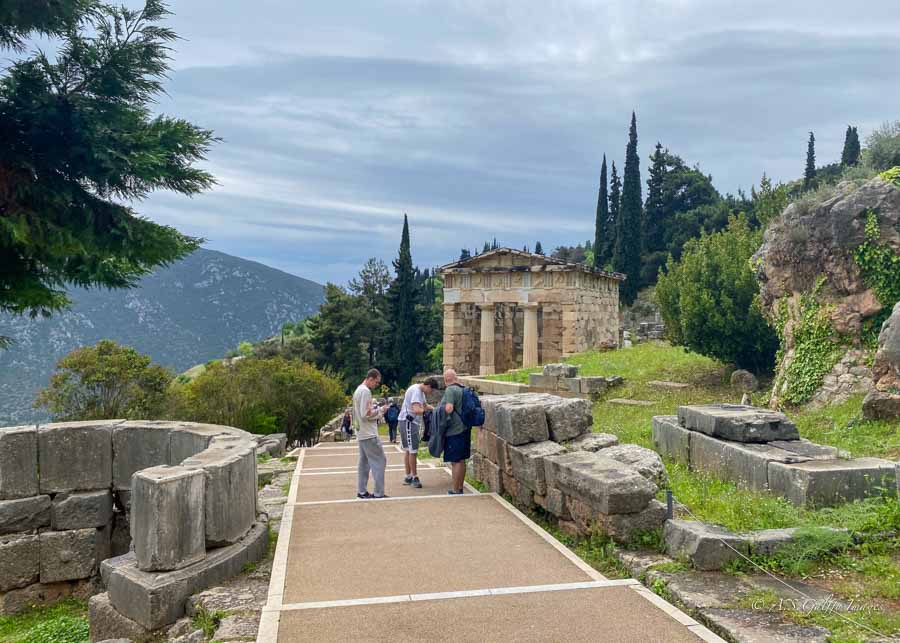
This extraordinary UNESCO World Heritage site was once considered the centre of the world by the ancient Greeks. The pan-Hellenic sanctuary of the Greek god Apollo and his priestess, Pythia. But why was the Oracle of Delphi so important to the ancient Greeks?
Knowing a little about the myths and legends that surround Delphi will help you better understand the huge historical and cultural significance of this beautiful archeological site.
Table of Contents
Where is Delphi?
The archeological site of Delphi lies on the slopes of Mount Parnassus, about 180 km from Athens and 121 km from Patras.
The ancient Greeks believed that Delphi marked the center of the known world as it was established by Zeus. An unusual rounded stone (called omphalos) was found at the site and is thought to indicate the exact central spot.
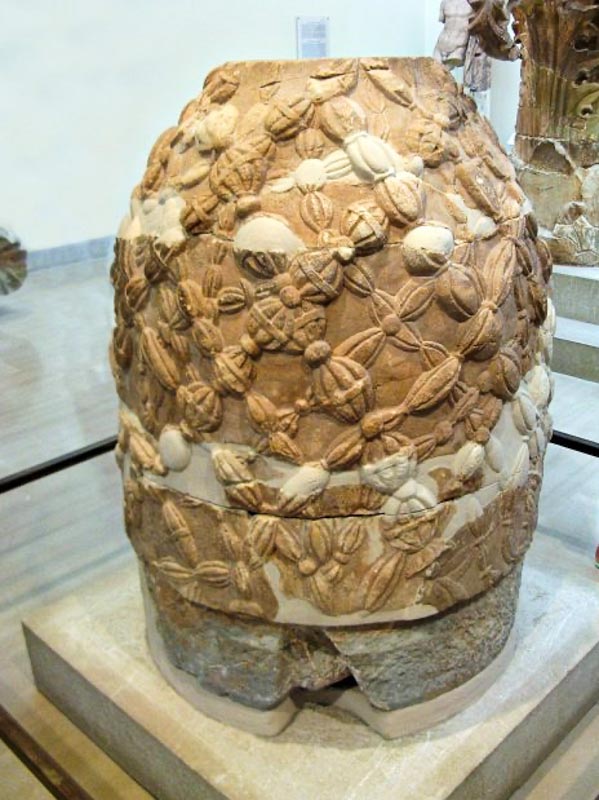
It’s likely that Delphi started as a small and insignificant site, but its location was next to a very important trade route between Corinth and Northern Greece. That determined Delphi’s succes as an international religious site. As trade around Greece began to increase, more and more visitors started to visit the sacred site of Delphi.
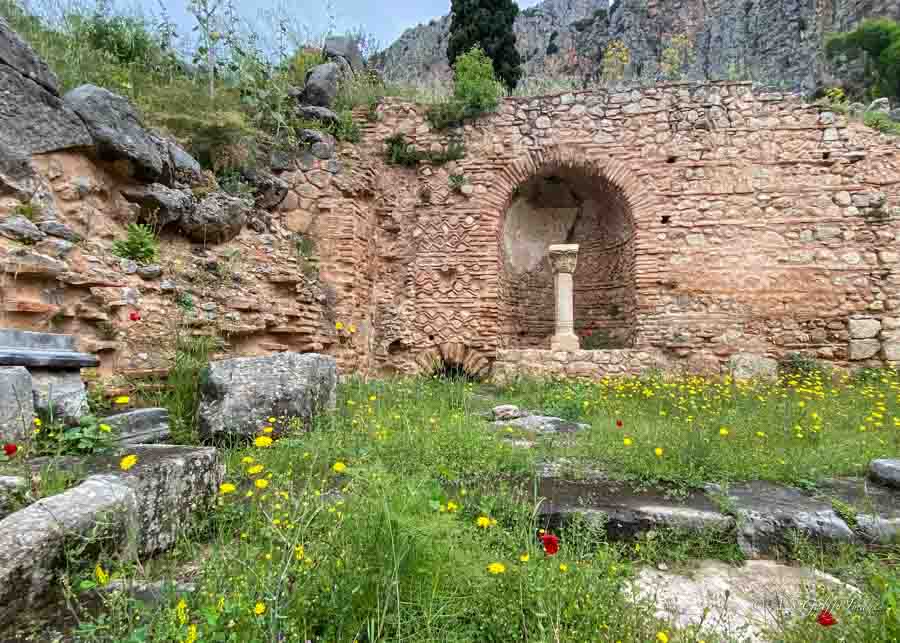
How to Get from Athens to Delphi
By Rental Car
Duration: 2.5 hours
Delphi was part of our 2 weeks in Greece itinerary, but we visited the site as a day trip from Athens. If you don’t already have a car, you can rent one at one of the agencies in the city center. However, driving in Athens is not exactly easy, so if you want to avoid it I recommend taking the train to Athens Airport and renting it from there. Prices are also lower at the airport than in the city center.
Getting from Athens to Delphi takes about 2.5 hours along highway E75 and EO48 (Note: there are tolls on this road). As Delphi is located in the mountains, the drive will take you through a fairly remote part of Greece, between rolling hills and olive orchards. It’s a beautiful journey through Attica Peninsula around the Gulf of Corinth.
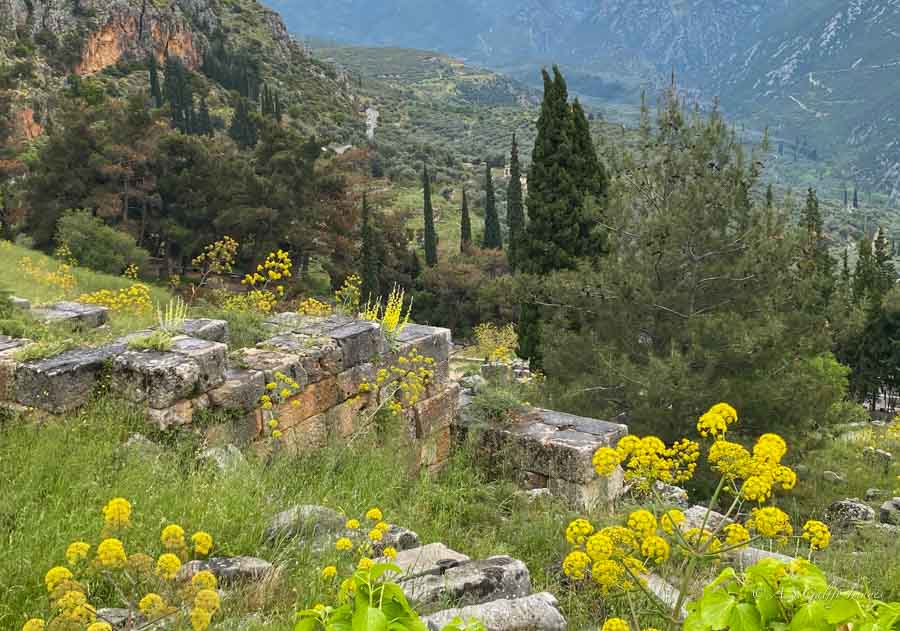
By Bus
Duration: 3 hours
Buses from Athens to Delphi run about about five-six times daily. You can buy tickes online, at the station, or on the bus (cash only).
The bus from Athens to Delphi leaves from KTEL Bus Station B, Liosion, which is located in the northern part of Athens, about a ten minute walk from the “Agios Nikolaos” stop on the M1 line (green line). Note that busses are often crowded on this route, as Delphi is the 3rd most visited archaeological site in Greece. So plan to arrive early at the station!
By Organized Tours
If you don’t like riding the bus or driving a car, we recommend checking out one of these day trips from Athens to Delphi.
Prices vary according to what the tour offers, so choose carefully. All these tours include transportation in an AC bus from Athens to Delphi. However, some tours only include transportation and an audio-guide, so you’ll have to pay your entrance ticket. Others have the ticket and a private guide included in the price. There are also tours that provide a pick-up from your hotel, in addition to transportation, ticket, and private guide.
You can also choose a private day trip to Delphi from Athens, but that is going to be way more expensive.
What Was the Oracle of Delphi?
The sanctuary at Delphi originated around 1400 B.C. as a shrine dedicated to the god Apollo. According to Greek mythology, Apollo killed the massive snake Python at Delphi. Following his victory, the Greeks erected a temple and an oracle on this site.
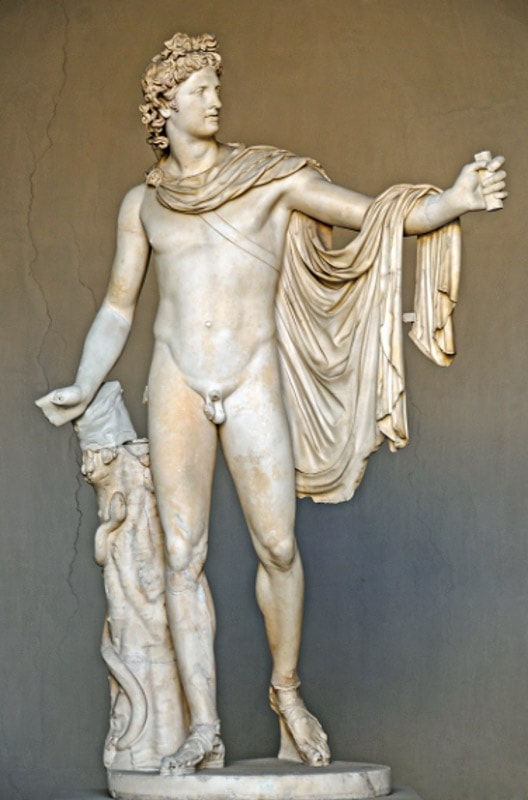
The Oracle of Delphi was one of the most powerful religious institutions in ancient Greece, a model for prophecy all around the globe. But what exactly is an oracle?
Greeks believed in the communication of divine knowledge from god to mortal, also known as divination. Divination took many forms, but the most common one was the practice of consulting a god through an intermediary. This intermediary was known as an oracle.
The Pythia of Delphi
In Ancient Greece, the Pythia (or Oracle of Delphi) was a highly regarded priestess. Greeks believed she had the power to channel prophecies from Apollo himself while being in a trance. Most likely, the trance was induced by the hallucinogenic gases that emerged from a crevice in the floor of the nearby Castalian Spring.
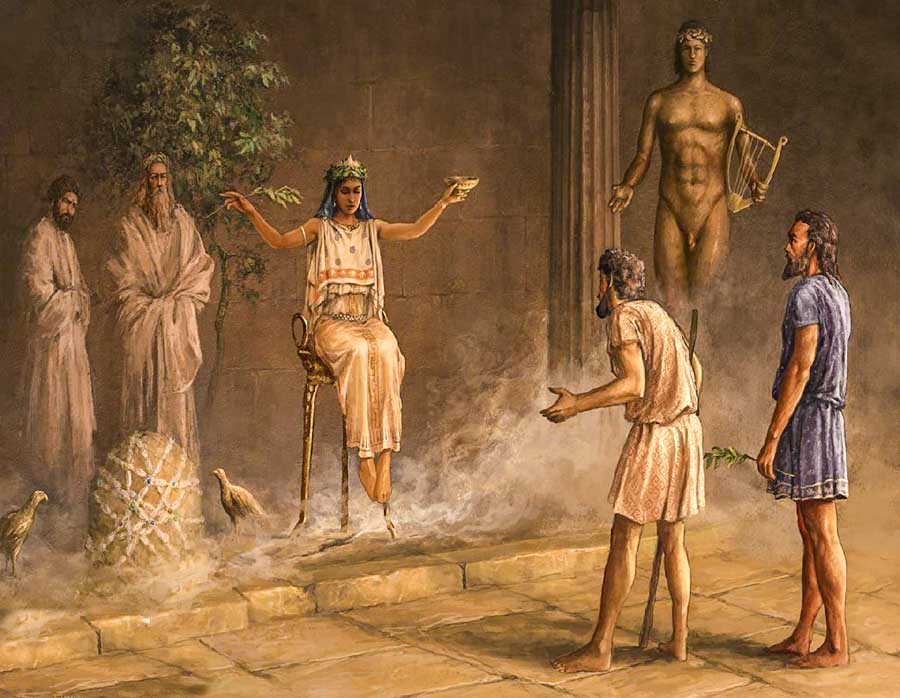
People came from all over Greece and beyond to have their questions about the future answered by the Oracle of Delphi. And her answers could determine the course of everything, whether there be a war, peace, or when a farmer should plant his seedlings.
A Pythia was chosen from among the priestesses of the temple upon the death of the previous Pythia. Pythias were likely women from higher-class families, with a good moral character. Once chosen they would serve for life and permanently live in a house at the sanctuary.
Visiting the Archeological Site of Delphi on a Day Trip from Athens
When coming from Athens to Delphi you’ll have the archeological site on your right hand side. Just look for the cars parked along the road and try to find a parking spot. There is no designated parking at the site.
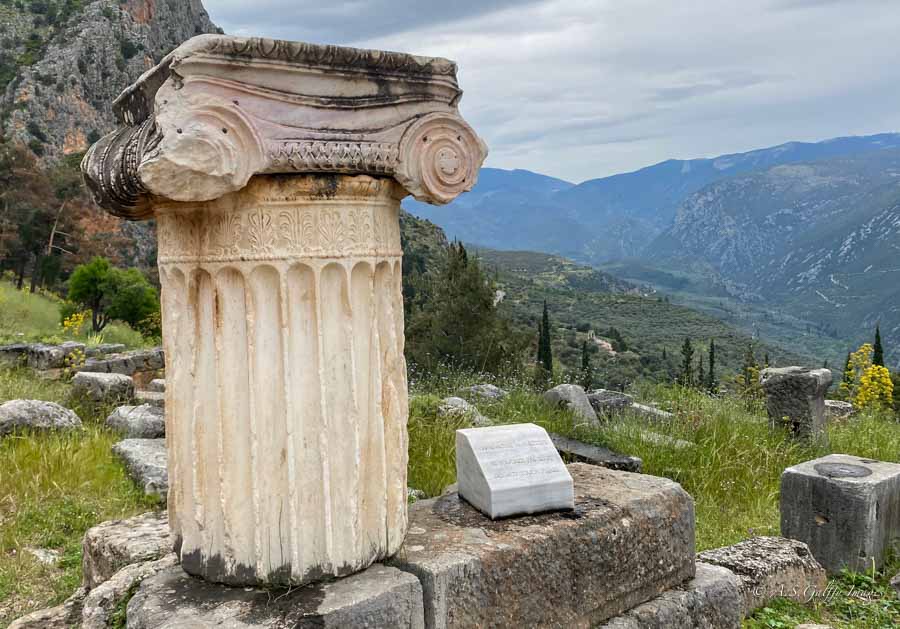
The first thing that will strike you when visiting the archeological site of Delphi is its remarkable location. As the morning mist starts clearing up and the ruins appear on the slope of the mountain, you’ll get a sense of mystical experience. It is easy to see why Greeks considered this a sacred place.
The Sacred Way
Delphi is easy to visit, just follow the Sacred Way path that winds up the mountain. Along the way you’ll come across different archeological remains that were once majestic temples, administrative buildings, dwellings, and also a theatre and a stadium. Although Delphi’s grandeur has faded today, you’ll still get glimpse into its glorious past.
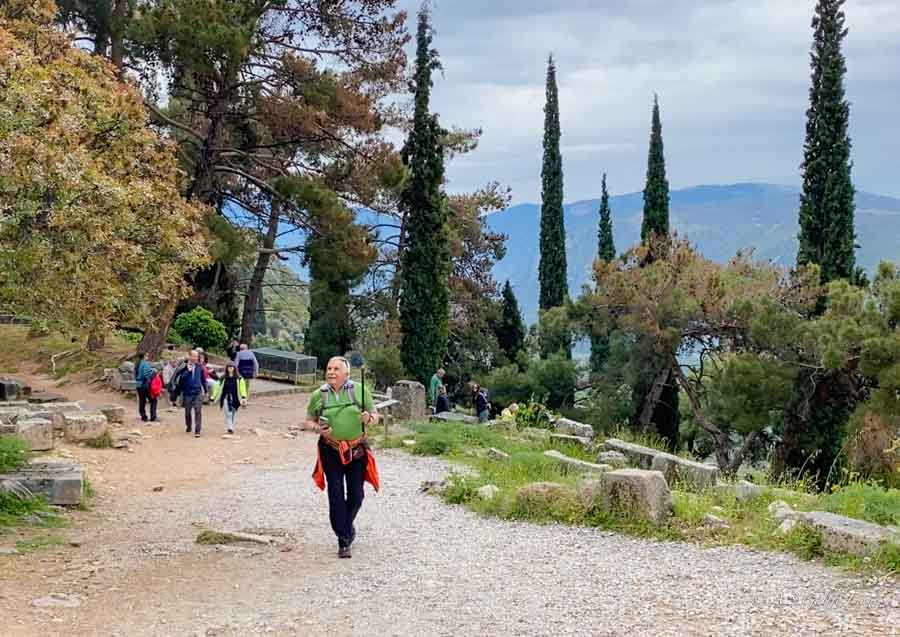
To better understand the historic importance of Delphi, think of the fact that its grounds were once sacred to the Greeks. They came here to venerate their gods with animal sacrifices and votive offerings. They would also come here to consult the oracle who promised to reveal them the past, present and future.
The Athenian Treasury
As people came to Delphi from all over Greece, they would bring offerings and place them along the Sacred Way, or in small buildings that resembled temples, called treasuries.
There are remnants of six such treasuries along the Sacred Way. But the one that is still standing today is the Treasury of the Athenians, which commemorates their victory against the Persians at the Battle of Marathon (490BC).
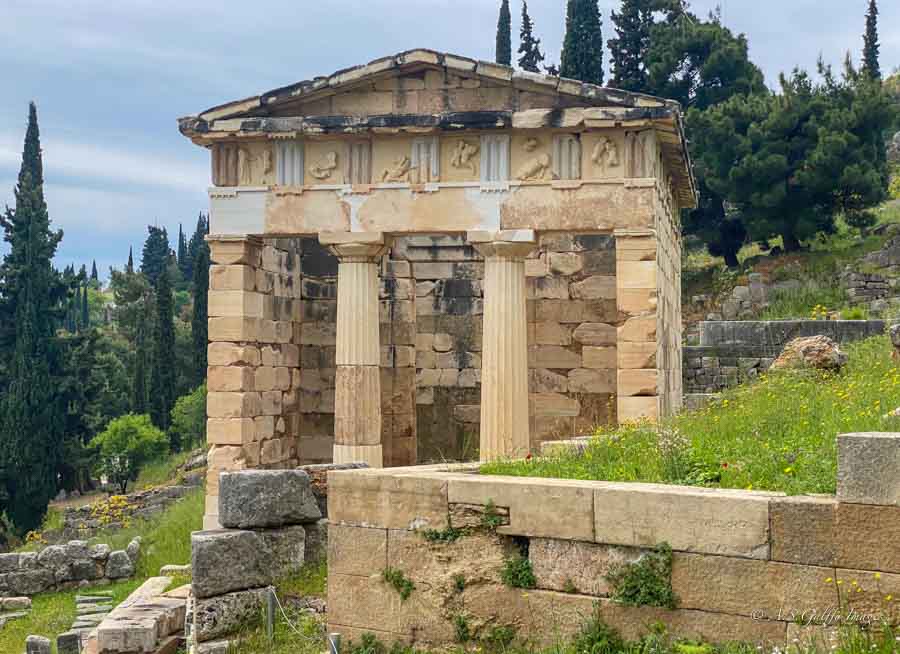
The treasury has a rectangular foundation on three levels and an inner chamber that you can access from the front porch. The architectural style of the temple is Doric and the main construction material is marble.
Originally, the exterior of the building had impressive reliefs depicting the adventures of Hercules and Theseus, while the interior space had hymns dedicated to Apollo carved on the walls.
The Stoa of the Athenians
Among the most important sites at Delphi is the Stoa of the Athenians, located south of the Temple of Apollo. This remarkable portico built in the Ionic style dates back to 478 B.C. and was meant for storing the war spoils from naval victories against the Persians.
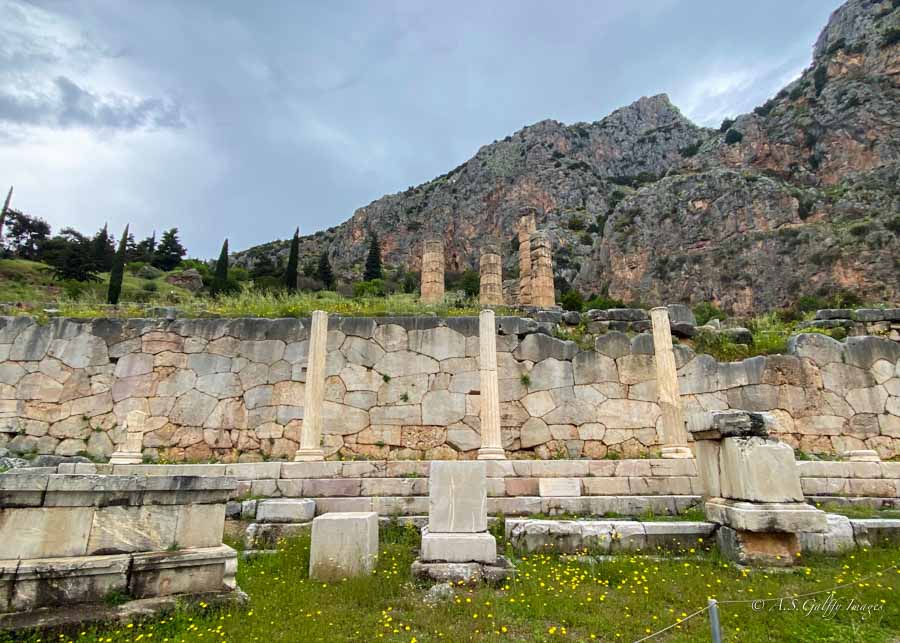
Today only three of the eight Ionic columns of the Stoa are still standing, next to the Polygonal wall.
The Serpent Column
As you continue your walk up the Sacred Way you’ll come across the Serpent Column. This is a 26-foot high bronze monument that consists of three snakes twisting around each other. The column was part of a victory tripod dedicated to the Temple of Apolo in Delphi after the Greeks defeated the Persians in the Battle of Plataea in 479 BC.
The three snakes have the names of the cities that had participated in Battle of Plataea engraved on their bodies. But after two-and-a-half millennia, it’s difficult to read the names on the bronze coils!
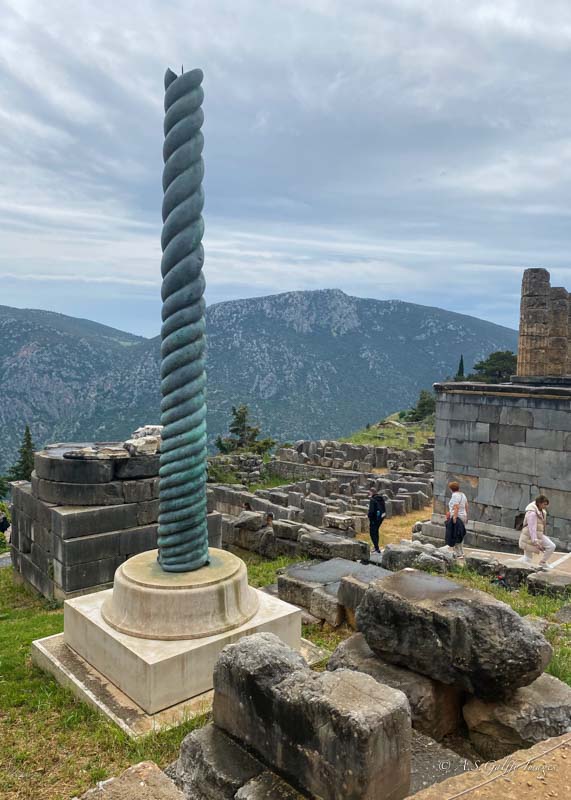
The Serpent Column has a very interesting story. According to the Greek historian Herodotus, the column was built with bronze from the melted-down Persian weapons. The heads of the snakes supported a golden cauldron, that the Phoceans melted to fund the Third Sacred War.
In 324 AD, Constantine the Great took the Column to Constantinople to decorate his new Hippodrome. The serpent heads remained intact till the end of the 17th century, when they mysteriously broke while the column was still in Constantinople.
What’s interesting to notice is that although it was on public display for over 2300 years, the Serpent Column somehow survived through all the perils. Very few other Hellenic bronze masterpieces had this kind of luck!
The Temple of Apollo
At the center of the archeological site of Delphi, right next to the Serpent Column, lies the Temple of Apollo. The temple was first erected in the 7th century B.C., but over the centuries it was destroyed and rebuilt many times. Originally, this sanctuary was enclosed by a wall which separated it from the city. The wall is still visible today at some locations.
In the 6th century BC, after a fire destroyed it completely, the temple was rebuilt and renamed the “Temple of Alcmeonidae,” in commemoration of the noble family who helped with the construction.
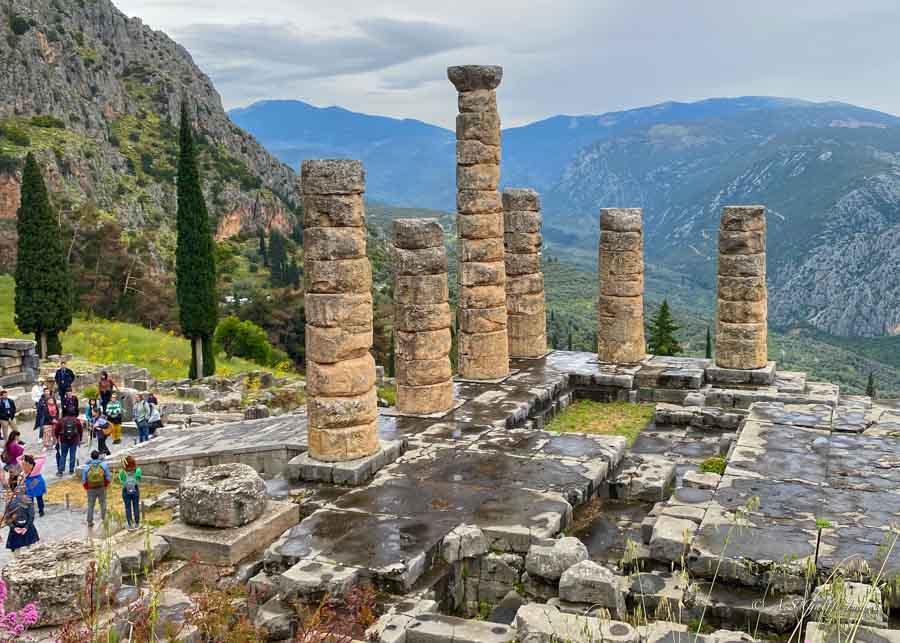
But this temple was also destroyed in 373 BC, this time by an earthquake. The third time around the Temple of Apollo was rebuilt by three architects from Corinth, which followed the same proportions and style as the previous construction. The temple had a peristyle consisting of 6 columns on the short ledge and 15 columns along the long ledge. Only the temple’s foundations survive today, along with several Doric columns.
The Ancient Theater of Delphi
The largest and most impressive structure still standing at Delphi is the ancient theatre. The theater, which is situated within the Temple of Apollo, initially hosted music contests for the Pythian Games. The first stone theatre was built of local limestone in the 4th century B.C.
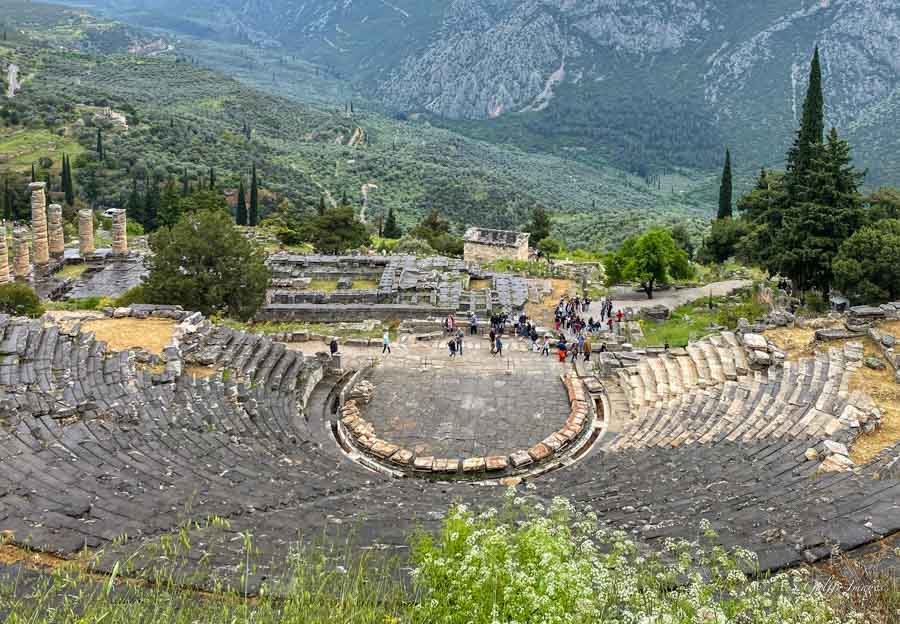
But the more monumental form you see today dates to the early Roman period (1st century AD). The theater has a capacity of 5,000 spectators and is divided into two zones by a horizontal passageway which facilitated the spectators’ movement within the theater. This newer theater was designed to stage lyrical and dramatic productions.
The Ancient Stadium
High up on the hill above the Temple of Apollo and the Ancient Theatre of Delphi, lies the Ancient Stadium, surrounded by wonderful lush greenery.
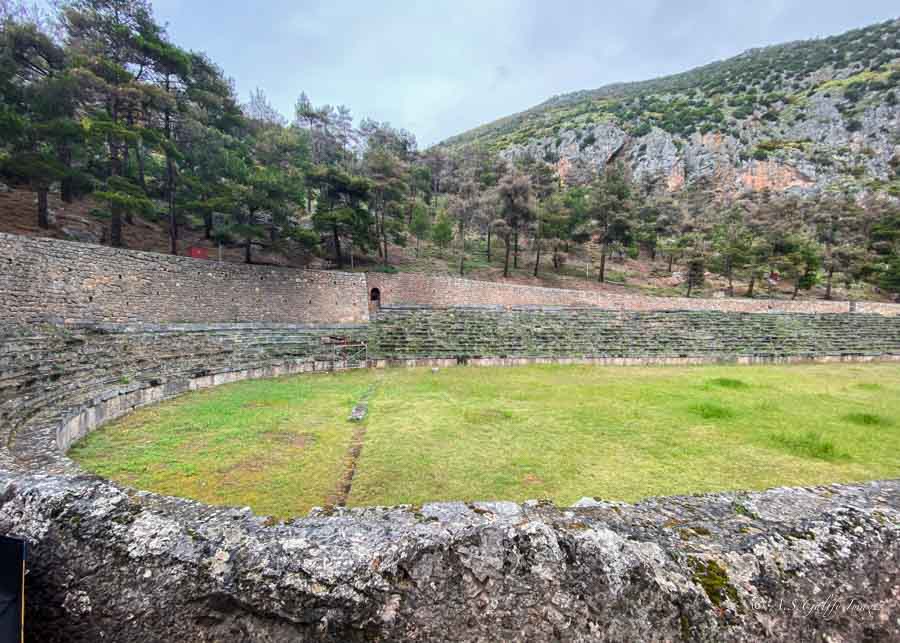
The stadium dates back to the 5th century B.C., but over the centuries it underwent many reconstructions. Its present form is from the 2nd century A.D., when Herodes Atticus financed the stone seatings.
The stadium was used for sports competitions, like the Pythian and Panhellenic Games, and could seat around 6,500 spectators.
The Temple of Athena Pronaia
One of the sites not to miss on your trip to Delphi is the Sanctuary of goddess Athena Pronaia, set just below the road about half a mile east of the Sanctuary of Apollo. Athena Pronaia was Apollo’s half-sister and her main role was to protect him. She was also considered the guardian of Pythia, so people coming to consult the oracle would first offer a sacrifice at the Athena Pronaia.

The sanctuary was the first structure of Delphi visible to people coming from Athens, before arriving at the Temple of Apollo. Hence the name Pronaia, which means “the one before” the temple of Apollo.
The sanctuary consisted of several altars, temples, two treasuries. However, the only structure still standing there today is the Tholos, a circular temple dating back to the 4th century B.C.
The Museum of Archeology at Delphi
The Archaeological Museum of Delphi is home to an impressive collection of artifacts discovered during the excavations at the Delphi oracle and the nearby area. The museum is adjacent to the archaeological site at Delphi and is one of the top must-see museums in Greece.
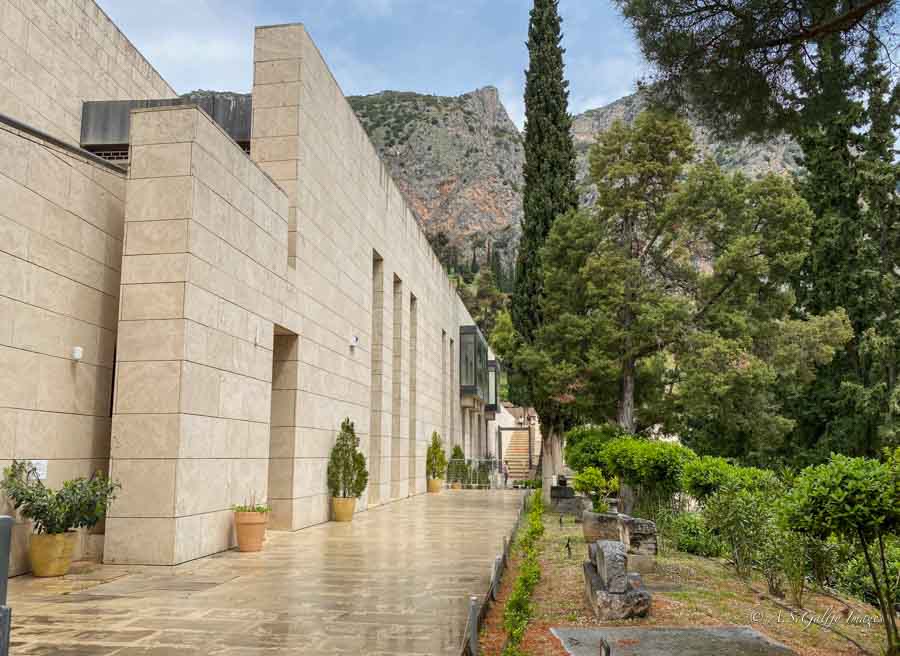
The collection encompasses artefacts from the 7th century B.C. through to the Roman era. One of the most magnificent offerings to the Sanctuary was the Sphinx from Naxos which dates to around 560 B.C. There are also segments from the Temple friezes, which are really impressive.
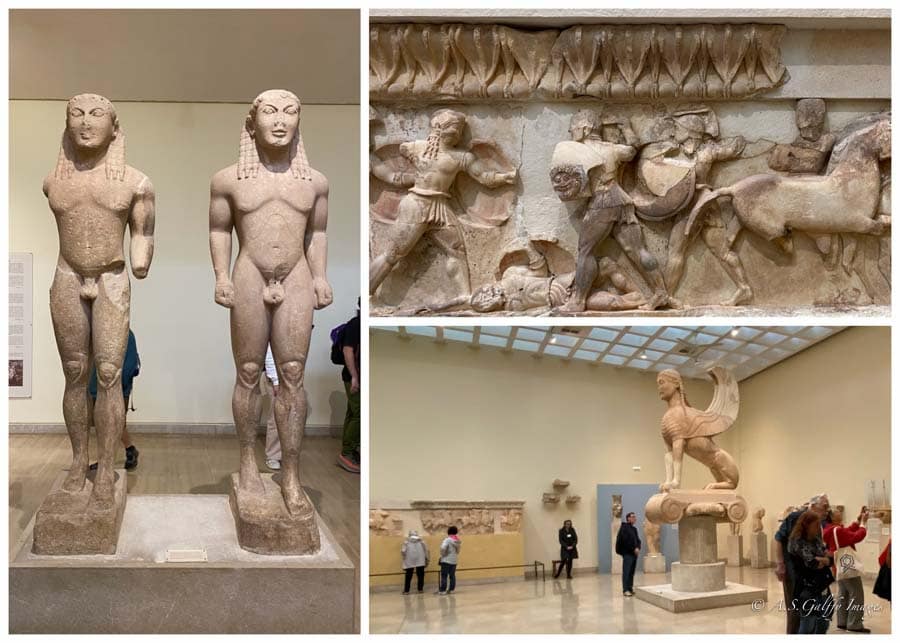
Best Time to Visit Delphi, Greece
The best time to visit Delphi is definitely in spring or fall, when the nights are cool and the days are pleasantly warm. Spring is particularly beautiful here, when the verdant valleys are sprinkled with wild flowers and endless orchards of olive trees.
Summers can be brutal in Greece, with temperatures reaching 100°F/40°C so Delphi will be hot too, although it’s up in the mountains. The scorching summer temperatures and the severe drought triggered devastating wildfires in this part of Greece in the last few years.
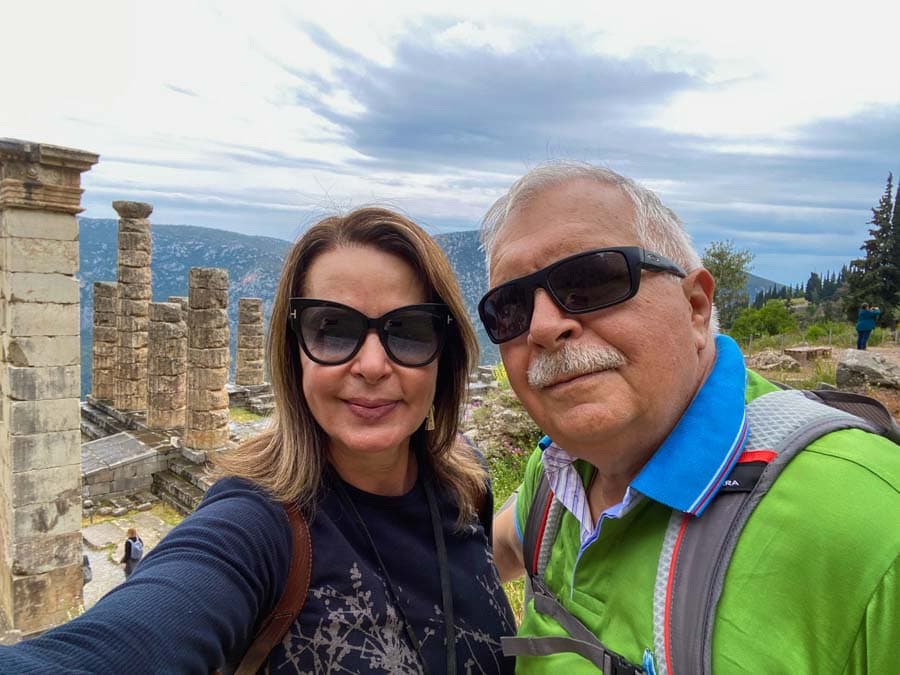
The lower the temperature the more you’ll enjoy Delphi, as there is a lot of hiking involved in visiting this site.
How Much Time to Spend in Delphi
If you only want to visit the archeological site, a full day should be enough in Delphi. Just make sure you arrive early to give yourself enough time for both the site and the Museum.
But if you don’t want to return to Athens in the evening, you can spend an extra day in Delphi taking trips to the mythological caves and springs in this area, or wandering through the lush forests. If you decide to spend one night in Delphi, don’t miss Hosios Loukas, one the oldest and most beautiful monasteries in Greece. You can also visit the nearby town of Arachova.
READ NEXT: What to Wear in Greece – the Ultimate Packing List
Practical Tips for Visiting Delphi, Greece
Delphi archeological site and museum are visited together and the admission fee is €12/person from April to October and €6 from November to March. The site is open between 8:00 am to 7:00 pm.
There are very rudimentary restroom facilities on the site, but I haven’t seen any water fountains. Therefore, I suggest bringing at least 1 liter of water with you as it gets pretty warm up here, even in spring or in fall.
I also suggest to start your visit at the museum and then move to the archeological site. The museum is not very big and it’s very well organized. You’ll get a lot of insight into the history of Delphi and see some remarkable artifacts. Most organized trips from Athens drop you directly at the archeological site of Delphi, so make sure you don’t miss this wonderful museum!
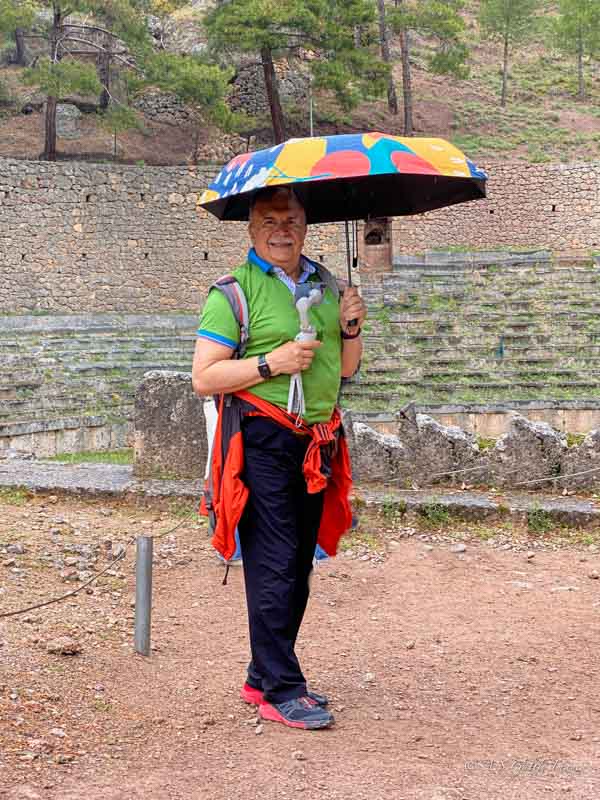
Also, you should dress in layers and bring an umbrella as the weather may change abruptly in the mountains. If you visit Greece in fall or in spring, the weather may get from sunny to rainy and back within a couple of hours. I recommend wearing hiking shoes, as the terrain is steep and uneven. If you visit in summer, which I don’t recommend, make sure you wear a hat and lots of sunscreen as the sun is brutal here.
If you found this information useful, please pin it to help others discover Delphi, Greece:
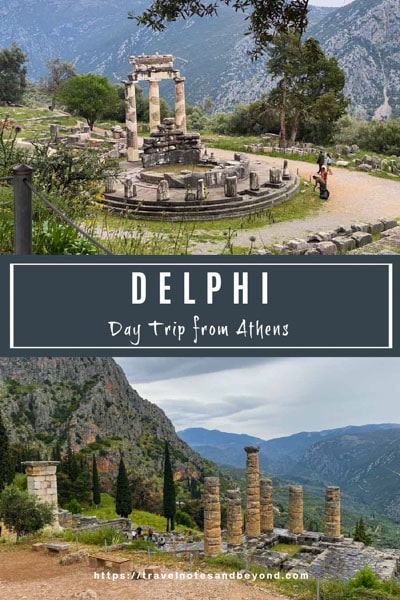

 6 Perfect Day Trips from Athens for Archeology Lovers
6 Perfect Day Trips from Athens for Archeology Lovers


